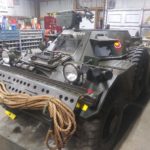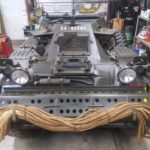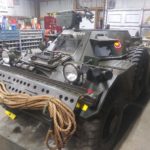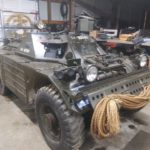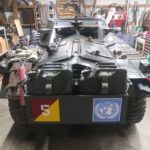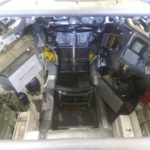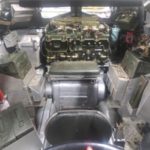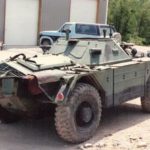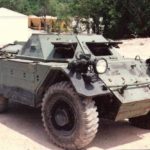History
Daimler Ferret Armored Cars
The Ferret armored car is a small, fast, wheeled British light-armored fighting reconnaissance vehicle. The Ferret evolved from the earlier successful 4.1-liter Daimler armored car, also a fast wheeled scout car, which was used extensively throughout North Africa and Europe in WWII. Designed and built by the UK luxury car maker Daimler Company, 4406 Ferrets were produced between 1952 and 1971 for use by British and other commonwealth countries. Powered by the 130hp Rolls Royce B60 inline-6 petrol engine, Ferrets were normally governed to speeds of 58mph, but can reach 80mph ungoverned. With 5 forward and 5 reverse gears, the 4-wheel drive Ferret can go as fast backwards as forwards. The Ferret’s unibody design makes it both strong and mobile for off-road operations and low-profile, fast and agile to survive urban environments. Its crew consists of either a commander and a driver/ radio operator in the turret-less fast reconnaissance Ferret or a commander, a driver/radio operator, and a gunner in the turreted model. Turret-less Ferrets had an externally mounted 0.30 M1919 Browning machine gun. Turreted models initially featured the 0.30 caliber machine gun and later transition to machine guns using the standard NATO 7.62x15mm round. The Ferret served widely around the world in large-scale conflicts, such as the 1991 Gulf war, and for many smaller internal peacekeeping roles. While a few Ferrets remain in service today, the British Army has operationally replaced the Ferrets with the tracked Scorpion, Scimitar and Ajax series of tracked combat reconnaissance vehicles.
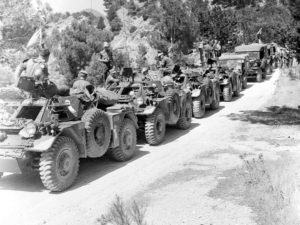
Our 1953 Ferret is the second vehicle from the front. This picture was taken in Egypt (Suez Crisis) when the unit was deployed from Canada for operations in 1956. Pictures and records were provided with the original vehicle war diary and logbook which survived its years of service.
RECovery
1953 Daimler Ferret
Our 1953 Daimler Ferret served in Egypt from 1956-1959 and in Cyprus from 1964-1969 according to its war diary. It was sold as government surplus and purchased from the Canadian Army by a US Citizen in 1980. We are the 4th owners since its surplus with the previous owner being from Blue Springs, Missouri. The African Queen Ferret was acquired in 1989 and sat in storage until it was converted back to its original configuration in 2019. Canadian Army Ferrets did not have turrets (unlike the British Ferrets) and this particular Ferret had been converted to the British style with a turret in 1986 by the previous owner. As part of its restoration the turret was removed and placed into storage for future needs. When purchased much of the interior equipment such as radios, ammo cans, fire extinguishers etc. were included and made the restoration much easier. The African Queen Ferret is street legal, and currently licensed and insured.
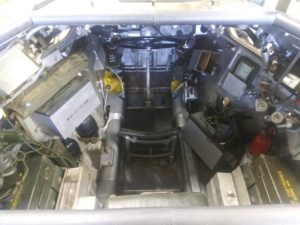
Interior picture shows how tight the fighting compartment is for the two man crew . The vehicle commander sits on a small jump seat (bottom of the picture) behind the driver with just enough room for legs behind the drivers backrest.
REStoraTION
KEEPING IT ORIGINAL
The Ferret’s Rolls Royce B60 engine has been rebuilt and the drive train inspected for excessive wear. Fortunately the Ferret was in excellent condition and a testament to the maintenance performed by the various crew members over the years. As one can imagine, parts can be a bit of an issue as most come from overseas and all from outside the United States. So far, the most challenging single item to find was the original 0.30 caliber machine gun mount, due to cost and rarity. A mount was eventually located in England and purchased in 2018. We are now scanning the globe for replacements for the aging tires. Unfortunately, the original tires are only being produced in South Africa and cost may be a deterrent. However, our spare tire is in excellent condition so we do have a backup as required. Sourcing original equipment has taken time but at this time, the Ferret’s restoration is almost complete.
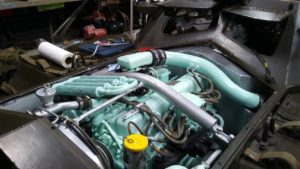
Rolls Royce B60 engine is six cylinder and produces 130 HP. The engine is powered by gasoline.
PReservation
KEEPING IT Original
Current preservation projects for the Ferret are the fuel cell restoration and tracking down new tires. Over time the welded and soldered seams of the fuel cell have begun to leak. The fuel cell is a saddle tank built to sit over the frame behind the armored crew compartment. Soldering the tank is a precise operation and the tank was sent to a specialty company to have the repairs made. In addition the tank was lined with a protective inner coating to prevent modern fuels containing ethanol from damaging the tank in the future. The rubber mounting grommets were also replaced to keep vibration to the fuel cell at a minimum.
Current Ferret initiatives and efforts:
- Purchase Replacement Tires ($TBD)
- Purchase Replica 0.30 Cal. Machine Gun ($1500)
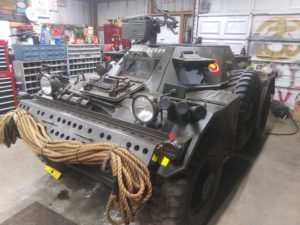
The ferret armored car was a low profile fast moving vehicle perfect for the scouting role it was designed to perform. 4,406 Ferrets were produced and continued to serve with British forces until 1991
Images of the 1953 Daimler Ferret
LEarn More
Other AQ Project Vehicles:
1943 M16A2 Half-track
1942 Ford GPW Jeep
1953 M37 3/4 Ton Truck
Additional Information:
